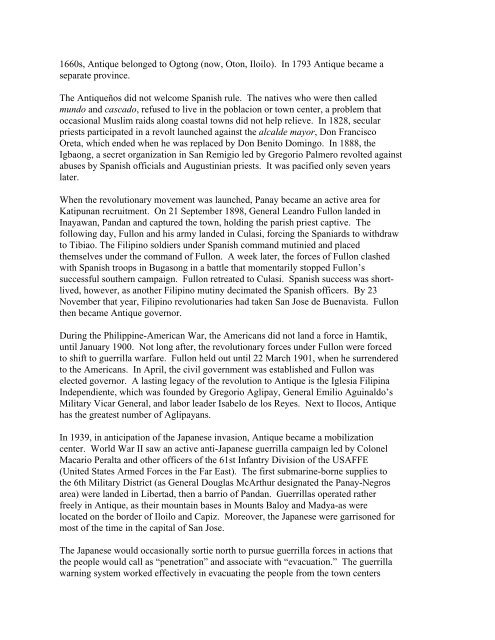Kinaray-a
Kinaray-a
Kinaray-a
Create successful ePaper yourself
Turn your PDF publications into a flip-book with our unique Google optimized e-Paper software.
1660s, Antique belonged to Ogtong (now, Oton, Iloilo). In 1793 Antique became a<br />
separate province.<br />
The Antiqueños did not welcome Spanish rule. The natives who were then called<br />
mundo and cascado, refused to live in the poblacion or town center, a problem that<br />
occasional Muslim raids along coastal towns did not help relieve. In 1828, secular<br />
priests participated in a revolt launched against the alcalde mayor, Don Francisco<br />
Oreta, which ended when he was replaced by Don Benito Domingo. In 1888, the<br />
Igbaong, a secret organization in San Remigio led by Gregorio Palmero revolted against<br />
abuses by Spanish officials and Augustinian priests. It was pacified only seven years<br />
later.<br />
When the revolutionary movement was launched, Panay became an active area for<br />
Katipunan recruitment. On 21 September 1898, General Leandro Fullon landed in<br />
Inayawan, Pandan and captured the town, holding the parish priest captive. The<br />
following day, Fullon and his army landed in Culasi, forcing the Spaniards to withdraw<br />
to Tibiao. The Filipino soldiers under Spanish command mutinied and placed<br />
themselves under the command of Fullon. A week later, the forces of Fullon clashed<br />
with Spanish troops in Bugasong in a battle that momentarily stopped Fullon’s<br />
successful southern campaign. Fullon retreated to Culasi. Spanish success was shortlived,<br />
however, as another Filipino mutiny decimated the Spanish officers. By 23<br />
November that year, Filipino revolutionaries had taken San Jose de Buenavista. Fullon<br />
then became Antique governor.<br />
During the Philippine-American War, the Americans did not land a force in Hamtik,<br />
until January 1900. Not long after, the revolutionary forces under Fullon were forced<br />
to shift to guerrilla warfare. Fullon held out until 22 March 1901, when he surrendered<br />
to the Americans. In April, the civil government was established and Fullon was<br />
elected governor. A lasting legacy of the revolution to Antique is the Iglesia Filipina<br />
Independiente, which was founded by Gregorio Aglipay, General Emilio Aguinaldo’s<br />
Military Vicar General, and labor leader Isabelo de los Reyes. Next to Ilocos, Antique<br />
has the greatest number of Aglipayans.<br />
In 1939, in anticipation of the Japanese invasion, Antique became a mobilization<br />
center. World War II saw an active anti-Japanese guerrilla campaign led by Colonel<br />
Macario Peralta and other officers of the 61st Infantry Division of the USAFFE<br />
(United States Armed Forces in the Far East). The first submarine-borne supplies to<br />
the 6th Military District (as General Douglas McArthur designated the Panay-Negros<br />
area) were landed in Libertad, then a barrio of Pandan. Guerrillas operated rather<br />
freely in Antique, as their mountain bases in Mounts Baloy and Madya-as were<br />
located on the border of Iloilo and Capiz. Moreover, the Japanese were garrisoned for<br />
most of the time in the capital of San Jose.<br />
The Japanese would occasionally sortie north to pursue guerrilla forces in actions that<br />
the people would call as “penetration” and associate with “evacuation.” The guerrilla<br />
warning system worked effectively in evacuating the people from the town centers
















